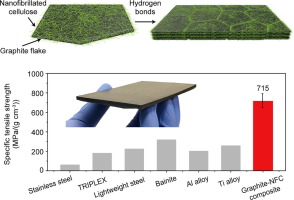当前位置:
X-MOL 学术
›
Mater. Today
›
论文详情
Our official English website, www.x-mol.net, welcomes your
feedback! (Note: you will need to create a separate account there.)
A printed, recyclable, ultra-strong, and ultra-tough graphite structural material
Materials Today ( IF 21.1 ) Pub Date : 2019-11-01 , DOI: 10.1016/j.mattod.2019.03.016 Yubing Zhou , Chaoji Chen , Shuze Zhu , Chao Sui , Chao Wang , Yudi Kuang , Upamanyu Ray , Dapeng Liu , Alexandra Brozena , Ulrich H. Leiste , Nelson Quispe , Hua Guo , Azhar Vellore , Hugh A. Bruck , Ashlie Martini , Bob Foster , Jun Lou , Teng Li , Liangbing Hu
Materials Today ( IF 21.1 ) Pub Date : 2019-11-01 , DOI: 10.1016/j.mattod.2019.03.016 Yubing Zhou , Chaoji Chen , Shuze Zhu , Chao Sui , Chao Wang , Yudi Kuang , Upamanyu Ray , Dapeng Liu , Alexandra Brozena , Ulrich H. Leiste , Nelson Quispe , Hua Guo , Azhar Vellore , Hugh A. Bruck , Ashlie Martini , Bob Foster , Jun Lou , Teng Li , Liangbing Hu

|
Abstract The high mechanical performance of common structural materials (e.g., metals, alloys, and ceramics) originates from strong primary bonds (i.e., metallic, covalent, ionic) between constituent atoms. However, the large formation energy of primary bonds requires high temperatures in order to process these materials, resulting in significant manufacturing costs and a substantial environmental footprint. Herein, we report a strategy to leverage secondary bonds (e.g., hydrogen bonds) to produce a high-performance and low-cost material that outperforms most existing structural compounds. By dispersing graphite flakes and nanofibrillated cellulose (NFC) in water at room temperature to form a stable and homogeneous solution with a high solid concentration (20 wt%), we demonstrate this slurry can be scalably printed to manufacture a graphite-NFC composite that exhibits a high tensile strength (up to 1.0 GPa) and toughness (up to 30.0 MJ/m3). The low density of graphite and cellulose leads to a specific strength of the composite (794 MPa/(g cm−3)) that is significantly greater than most engineering materials (e.g., steels, aluminum, and titanium alloys). We demonstrate how hydrogen bonds between the graphite flakes and NFC play a pivotal role in the superb mechanical performance of the composite, also enabling this low-cost material to be recyclable for an environmentally sustainable solution to high performance structural materials.
中文翻译:

一种印刷、可回收、超强、超韧的石墨结构材料
摘要 普通结构材料(例如金属、合金和陶瓷)的高机械性能源于组成原子之间的强初级键(即金属、共价、离子)。然而,初级键的大形成能需要高温来处理这些材料,从而导致显着的制造成本和大量的环境足迹。在此,我们报告了一种利用二级键(例如氢键)来生产性能优于大多数现有结构化合物的高性能和低成本材料的策略。通过在室温下将石墨薄片和纳米原纤化纤维素 (NFC) 分散在水中,形成具有高固体浓度 (20 wt%) 的稳定均匀溶液,我们证明了这种浆料可以进行可扩展印刷,以制造具有高拉伸强度(高达 1.0 GPa)和韧性(高达 30.0 MJ/m3)的石墨-NFC 复合材料。石墨和纤维素的低密度导致复合材料的比强度 (794 MPa/(g cm−3)) 明显高于大多数工程材料(例如钢、铝和钛合金)。我们展示了石墨薄片和 NFC 之间的氢键如何在复合材料的卓越机械性能中发挥关键作用,同时也使这种低成本材料能够回收利用,从而成为高性能结构材料的环境可持续解决方案。石墨和纤维素的低密度导致复合材料的比强度 (794 MPa/(g cm−3)) 明显高于大多数工程材料(例如钢、铝和钛合金)。我们展示了石墨薄片和 NFC 之间的氢键如何在复合材料的卓越机械性能中发挥关键作用,同时也使这种低成本材料能够回收利用,从而成为高性能结构材料的环境可持续解决方案。石墨和纤维素的低密度导致复合材料的比强度 (794 MPa/(g cm−3)) 明显高于大多数工程材料(例如钢、铝和钛合金)。我们展示了石墨薄片和 NFC 之间的氢键如何在复合材料的卓越机械性能中发挥关键作用,同时也使这种低成本材料能够回收利用,从而成为高性能结构材料的环境可持续解决方案。
更新日期:2019-11-01
中文翻译:

一种印刷、可回收、超强、超韧的石墨结构材料
摘要 普通结构材料(例如金属、合金和陶瓷)的高机械性能源于组成原子之间的强初级键(即金属、共价、离子)。然而,初级键的大形成能需要高温来处理这些材料,从而导致显着的制造成本和大量的环境足迹。在此,我们报告了一种利用二级键(例如氢键)来生产性能优于大多数现有结构化合物的高性能和低成本材料的策略。通过在室温下将石墨薄片和纳米原纤化纤维素 (NFC) 分散在水中,形成具有高固体浓度 (20 wt%) 的稳定均匀溶液,我们证明了这种浆料可以进行可扩展印刷,以制造具有高拉伸强度(高达 1.0 GPa)和韧性(高达 30.0 MJ/m3)的石墨-NFC 复合材料。石墨和纤维素的低密度导致复合材料的比强度 (794 MPa/(g cm−3)) 明显高于大多数工程材料(例如钢、铝和钛合金)。我们展示了石墨薄片和 NFC 之间的氢键如何在复合材料的卓越机械性能中发挥关键作用,同时也使这种低成本材料能够回收利用,从而成为高性能结构材料的环境可持续解决方案。石墨和纤维素的低密度导致复合材料的比强度 (794 MPa/(g cm−3)) 明显高于大多数工程材料(例如钢、铝和钛合金)。我们展示了石墨薄片和 NFC 之间的氢键如何在复合材料的卓越机械性能中发挥关键作用,同时也使这种低成本材料能够回收利用,从而成为高性能结构材料的环境可持续解决方案。石墨和纤维素的低密度导致复合材料的比强度 (794 MPa/(g cm−3)) 明显高于大多数工程材料(例如钢、铝和钛合金)。我们展示了石墨薄片和 NFC 之间的氢键如何在复合材料的卓越机械性能中发挥关键作用,同时也使这种低成本材料能够回收利用,从而成为高性能结构材料的环境可持续解决方案。











































 京公网安备 11010802027423号
京公网安备 11010802027423号